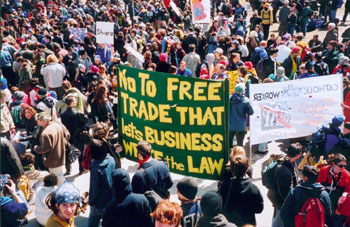Does the government or a corporation have hidden documents or secret plans? Liberate them!
This tactic is rooted in Gandhi’s strategy of nonviolent raids on colonial salt deposits. Even though it is unlikely to succeed directly, the ensuing controversy can nonetheless bring the undisclosed documents to the public’s attention. In several high-profile cases, the successful application of this tactic has created enough of an outcry to force the target to release the documents in question.
An Example
In 2001, Philippe Duhamel, co-founder of Operation Salami was working with a campaign to expose the secretive Free Trade Area of Americas (FTAA) trade agreement being negotiated by the Canadian government. Even senators and members of parliament could not see the negotiating texts — only key CEOs and the leaders of participating nations.
Weeks ahead of the Québec City Free Trade summit, the campaign announced it would attempt to “liberate” the texts for public scrutiny. On the day of the action, wave after wave of participants approached the police barricades erected (for their benefit) around the Department of Foreign Affairs and International Trade. Each wave read aloud a citizens’ search warrant: “Hello, my name is ____. Access to information is basic to democracy. Without that information we cannot have a meaningful public debate. We ask the police to do their job and help us search for the texts. Please let me through.”
The first wave went over and was promptly arrested. Over several hours, eighty people — some dressed as Robin Hood — climbed over the fence and attempted to liberate the documents.
As the public saw the lengths the government and corporations were going to hide the texts, public outrage mounted until eventually the Canadian government broke down and released the texts. Exposed to public scrutiny as the corporate coup d’état it was, the FTAA never moved forward.

